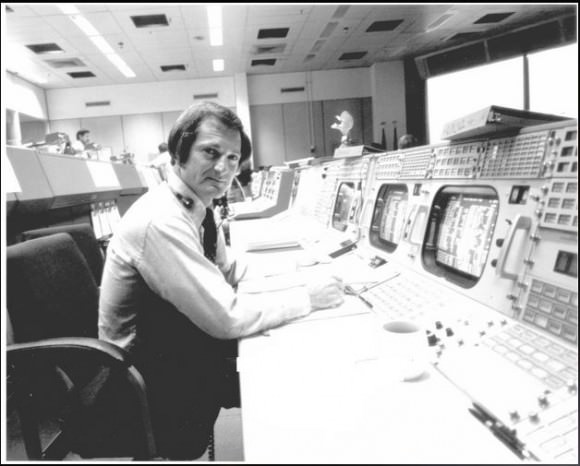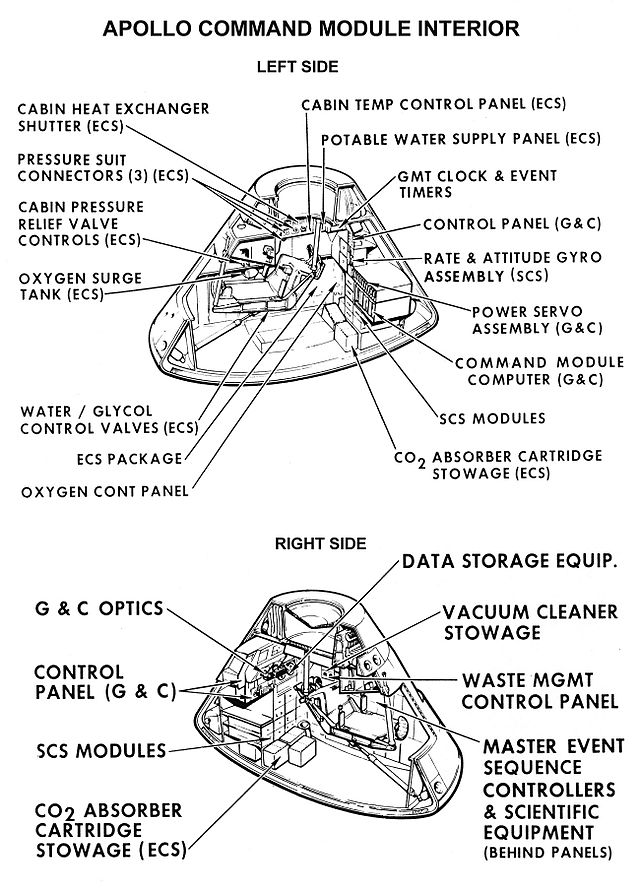Join Universe Today in celebrating the 45th anniversary of Apollo 13 with insights from NASA engineer Jerry Woodfill as we discuss various turning points in the mission.
Within minutes of the accident during the Apollo 13 mission, it became clear that Oxygen Tank 2 in the Service Module had failed. Then Mission Control radioed up procedures and several attempts were made to try to save the remaining oxygen in Tank 1. But the pressure readings continued to fall, and it soon became obvious that Tank 1 was going to fail as well. At that point, both the crew and those in Houston realized the extreme seriousness of the situation.
No oxygen meant the fuel cells would be inoperative, and the fuel cells produced electrical power, water and oxygen – three things vital to the lives of the crew and the life of the spacecraft.
For power in the Command Module, all that was left were the batteries, but they were to be the sole source of power available for reentry. Besides the ambient air in the CM, the only oxygen remaining was contained in a so called ‘surge tank’ and three reserve one pound O2 tanks. These, too, were also mainly reserved for reentry, but they were automatically tapped in emergencies if there any oxygen fluctuations in the system.
In Chris Kraft’s autobiography Flight: My Life in Mission Control, the former flight director and former director of Johnson Space Center cited Gene Kranz’ decision to immediately isolate or seal off the surge tank as being one of the things that made rescuing the crew possible.
Why was it so essential to assure that the spare oxygen surge tank in the CM was protected?
“With the luxury of nearly a half century to review each decision made during those April days in 1970,” said NASA engineer Jerry Woodfill, “we can look back and see that those in Mission Control indeed made the right decisions, but at the time, many of those decisions had to be made without knowing the full extent of the problem. But more importantly, they had the presence of mind to look beyond their immediate problem and see the big picture of how to save Apollo 13.”
Shortly after the accident, electrical output readings for fuel cells 1 and 3 were at zero. Fuel cell 2 was still working, but without oxygen from the main tanks, it began to pull oxygen from the reserve surge tank. The 3.7 lb capacity tank was called a ‘surge tank’ because one of its functions was to absorb pressure fluctuations in the oxygen system. Due to the depletion of the two main oxygen tanks, the remaining fuel cell 2 began to automatically pull from the surge tank’s small supply of oxygen.
However, the surge tank also served as the reserve tank of oxygen that the crew would use to breathe during reentry to Earth after the Service Module (with -– during a normal mission — its two large full and functioning oxygen tanks) had been jettisoned. But with those tanks damaged and empty, the remaining fuel cell was starting to draw on the surge tank’s small supply in order to keep power flowing.
Kranz’ decision to isolate the tank was important, but of course, he didn’t make that decision alone. In an article in IEEE Spectrum, the EECOM (Electrical Environmental and Consumables) officer for Apollo 13 Sy Liebergot, recalled the moment he realized the Service Module was running out of power and oxygen — permanently. He, too, didn’t make that realization alone.

As writer Stephen Cass explained in IEEE Spectrum, “Each flight controller in mission control was connected via so-called voice loops–pre-established audio-conferencing channels–to a number of supporting specialists in back rooms who watched over one subsystem or another and who sat at similar consoles to those in mission control.” (This includes the Mission Evaluation Room where Jerry Woodfill monitored the Caution and Warning System.)
Liebergot was in communications with a team down the hall from Mission Control in Building 30, consisting of Dick Brown, a power-systems specialist, and George Bliss and Larry Sheaks, both life support specialists. When they confirmed the surge tank was being tapped, they realized they had to revise their priorities, from stabilizing Odyssey to preserving the command module’s re-entry reserves so that the crew could eventually return to Earth.
Liebergot said his call to isolate the surge tank initially took Kranz off guard, as it was exactly opposite of what was needed to keep the last fuel cell operating.
But Liebergot and his team were looking ahead. “We want to save the surge tank which we will need for entry,” writer Cass quoted Liebergot, and Kranz almost immediately understood. “Okay, I’m with you. I’m with you,” said Kranz resignedly, and he ordered the crew to isolate the surge tank.

(Clockwise from lower right: Kraft, Gene Kranz, Glynn Lunney and John Hodge.) Credit: NASA.
“Because Gene was Flight Director at the time of the determination,” explained Woodfill, “his decisions result from inputs from a team of experts. He, like all the lead flight directors, is, ultimately, responsible for determining and weighing inputs from the chief system controllers who likewise receive instructions and information from a support team. To this end, ‘Flight’ is responsible for the final decision which is passed to the CapCom who, in turn, instructs the astronaut crew to act. Based on the process, often, an unknown expert might have been the original source of the instruction.”
This demonstrates how it was a team effort to save Apollo 13, and decisions that may have initially seemed incomprehensible ended up being the right ones.
“Loss of either Command Module capability — entry battery power or oxygen — threatened to be a fatal situation during the capsule’s entry return to Earth,” said Woodfill. Fortunately, as stated in one of our articles the first series of “13 Things,” a ‘jumper-charge technique dealt with the recharging the reentry batteries in the CM.
But while the LM had ample oxygen – in the form of oxygen tanks for repressurization after moon walks, tanks in the lander’s descent and ascent stages, and in the Portable Life Support System (PLSS) in the spacesuits that would have been used during moonwalks — apparently, there was no such similar way to replace oxygen in the CM from the lander’s oxygen stores.
Woodfill noted that had the surge tank been expended by the failed service module O2 tanks, there likely could have been a backup reentry plan of the crew wearing their launch suits and some type of jury-rigged system of using the oxygen from the PLSS system’s oxygen.
“A ‘shirt-sleeve’ entry would not have been the case,” said Woodfill. “This could have entailed a process similar to three scuba divers breathing from a pair of aqua lungs following the failure of one of the three.”
Woodfill noted one interesting fact. “Both Mission Control and the crew of Apollo 13 were so certain of the availability of surge tank oxygen that everyone agreed reentry would be space-suit-less.”
You can read more from Sy Liebergot in his book, Apollo EECOM, Journey of a Lifetime, and Chris Kraft in his book Flight: My Life in Mission Control.
Tomorrow: The Indestructible S-Band/Hi-Gain Antenna
Previous articles in this series:
Part 1: The Failed Oxygen Quantity Sensor
Part 2: Simultaneous Presence of Kranz and Lunney at the Onset of the Rescue
Part 3: Detuning the Saturn V’s 3rd Stage Radio
Part 4: Early Entry into the Lander
Part 5: The CO2 Partial Pressure Sensor
Part 6: The Mysterious Longer-Than-Expected Communications Blackout
Find all the original “13 Things That Saved Apollo 13″ (published in 2010) at this link.


great series so far nancy. thanks.
I am impressed by the communications structure at ground control. I had no idea it was this sophisticated and well thought out.